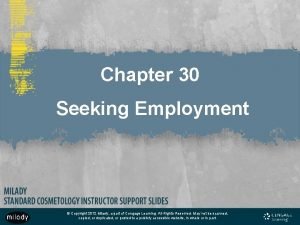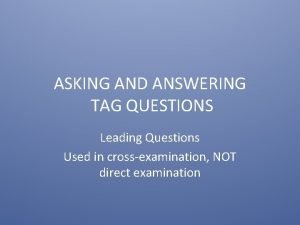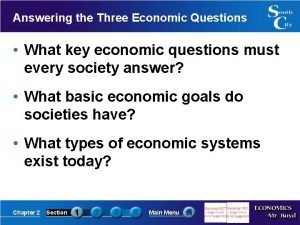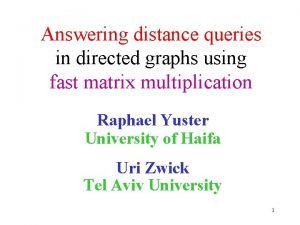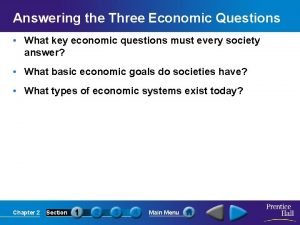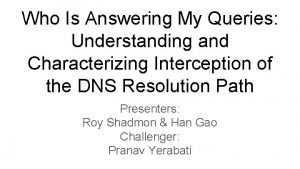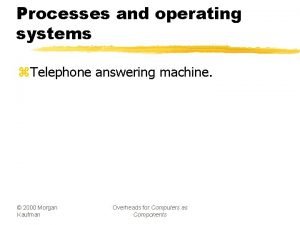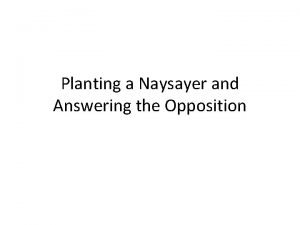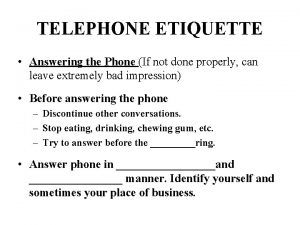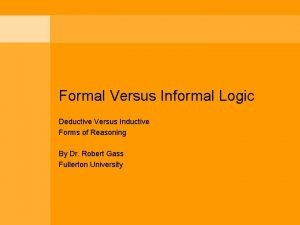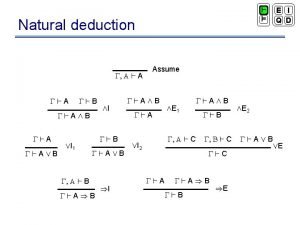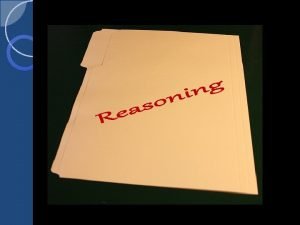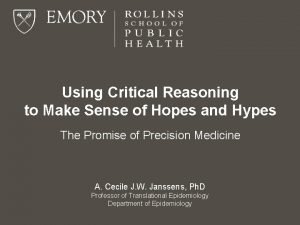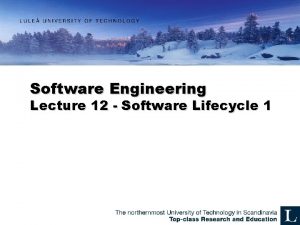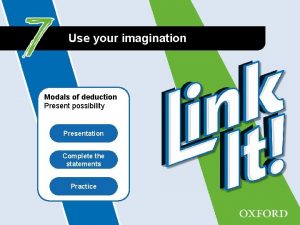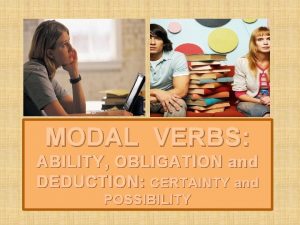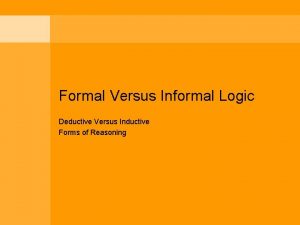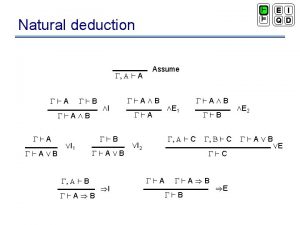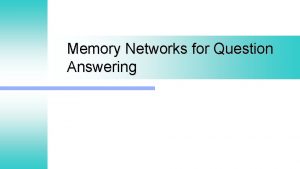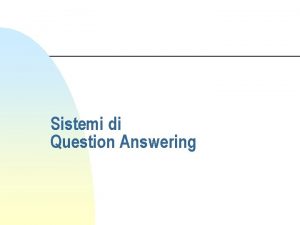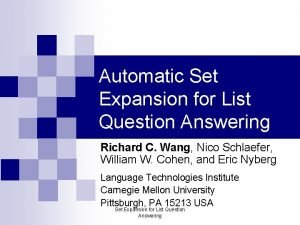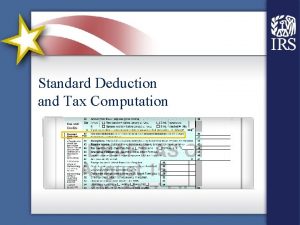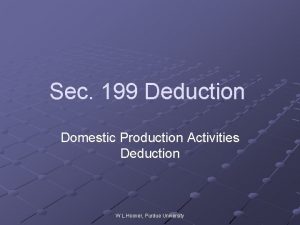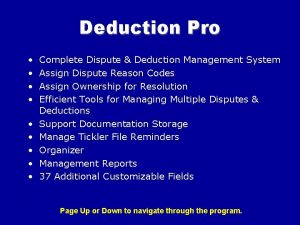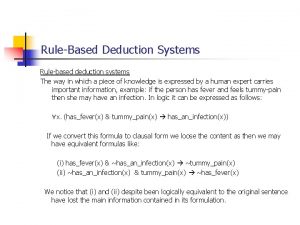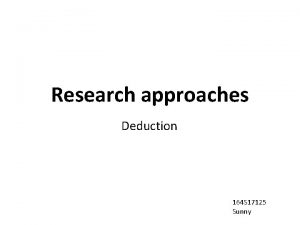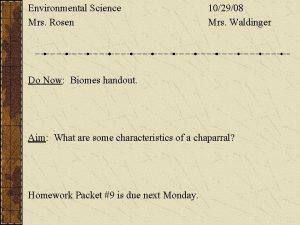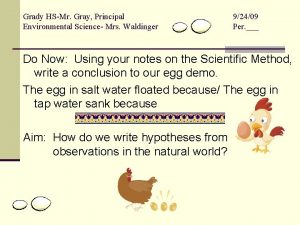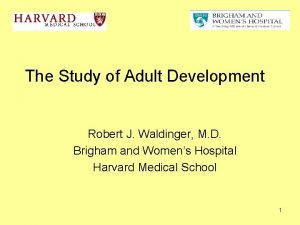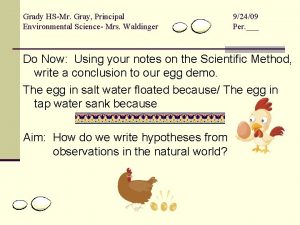automatic deduction applied automatic question answering richard waldinger


























![proto-implementation bio. Deducta Theorem Proving by SNARK [M. Stickel] Access to Data Sources via proto-implementation bio. Deducta Theorem Proving by SNARK [M. Stickel] Access to Data Sources via](https://slidetodoc.com/presentation_image_h2/ecbb4795781b7bb546a6e74bb0bc6e06/image-27.jpg)





- Slides: 32

automatic deduction applied: automatic question answering richard waldinger artificial intelligence center sri international third summer school on formal techniques atherton, california 23 may 2013

what do you mean, deductive question answering? encode subject domain knowledge as axiomatic theory. l phrase question as conjecture. l prove conjecture in theory. l extract answer from proof. l

answer extraction l l query conjecture is existentially quantified formula, exists (? x) p(? x) theorem prover tracks substitutions for ? x. (theorem prover restricted from substituting undefined term for ? x). answer obtained from trace of substitutions. waldinger based on program synthesis deductive question answering 4

program synthesis l l l extracting programs from proofs. arbitrary input. conditionals from case analysis. repetitive constructs from mathematical induction. hard. waldinger green (qa 3); waldinger and lee (prow); manna and waldinger deductive question answering 5

question answering is easy program synthesis l l l fixed, definite input. no conditionals (typically). no loops (usually). n logic programming. colmerauer n et al. , warren, kowalski deductive data bases minker waldinger deductive question answering 6

procedural attachment l l l Web or local resource (data, software) linked to symbol in theory. capabilities of resource specified by “axiomatic advertisement. ” resource consulted when symbol plays role in proof search. information provided by resource used by proof. resource virtually extends theory. Green waldinger et al. 1969; Weyhrauch ~1975 deductive question answering 14

geo. Logica and quark l l l query expressed in english. parsed (by gemini) into logical form. geographical domain theory provided with procedural attachments to Web resources. logical form proved (by SNARK). answer extracted from proof. included graphical answers (satellite imagery, maps…. ) sri waldinger group project deductive question answering 16

a geographical query Show a petrified forest in Zimbabwe within 200 miles of Lusaka, Zambia and north of the capital of Botswana. show(? y) & petrified. forest(? y) & in(? y, zimbabwe) & within(? y, ? z, feature(city, lusaka, zambia)) & measure. of(? u, ? z) mile. unit(? u) & value. of(? u, 200) & north. of (? y, ? v) & capital. of(? v, botswana) waldinger deductive question answering 17

resources invoked for petrified forest l l l l CIA world factbook found capital of botswana. alexandria digital library (ADL) gazetteer supplied latitudes and longitudes for zimbabwe, botswana, zambia, lusaka, and gabarone. ADL found “makuku fossil forest” in zimbabwe. geographical computation software resource checked north/south relation translation software resource transformed latitudes and longitudes. geographical software resource checked distance between forest and lusaka (112 miles). terra. Vision 3 d terrain viewer displayed forest. waldinger deductive question answering 18

makuku fossil forest waldinger deductive question answering 19

subject domains planetary astronomy l geography l intelligence analysis molecular biology l waldinger deductive question answering 20

cyanobacteria l l l bacteria that live in water and can perform photosynthesis (blue-green “algae”). origin of atmosphere. became chloroplast in original plants. created oil deposits. oldest known fossils. waldinger deductive question answering 21

cyanobacteria waldinger answering biology questions 22

high- and low-light cyanobacteria l Prochlorococcus sp. Med 4 (“promed 4”) n l high light (upper ocean). Prochlorococcus marinus mit 9313 (“mit 9313”) n low light (deeper ocean) What genes are involved in the adaptation to low or high light? Problem formulated by Jeff Elhai (Virginia Commonwealth University) waldinger deductive question answering 23

orthologs l l l genes in different species with a common ancestor gene. typically have the same function. detectable with software (e. g. , BLAST). waldinger deductive question answering 24

axiom: orthologs share function(? stimulus, ? gene 1, ? organism 1) gene-has-ortholog-inorganism(? gene 1, ? gene 2, ? organism 2) & function(? stimulus, ? gene 2, ? organism 2) “Orthologs share a common function”. “? ” indicates a variable, to be plugged in. “stimulus”, “gene”, “organism” are sort indicators. waldinger deductive question answering 25

logical form of question gene-in-organism(? gene 1, promed 4) & function(light, ? gene 1, promed 4) & not(exists (gene 2) ortholog(? gene 1, gene 2) & gene-in-organism(gene 2, mit 9313)) find a light-responsive gene in promed 4 that has no ortholog in mit 9313. ? -variables have existential quantification. “gene” is a sort indicator. submit as conjecture to theorem prover waldinger deductive question answering 26

procedural attachment gene-in-organism(? gene 1, promed 4) ? gene 1 -> pmed 4. pmm 001, …, . . pmed 4. pmm 0817, …, . . pmed 4. pmm 1716 from gene data in NCBI http: //ti. arc. nasa. gov/projects/amphion/animations/saturn-fromcassini-with-ansae. mpeg Cyanobase http: //www. ncbi. nih. gov/ etc. waldinger deductive question answering 27 call a typical one pmmn


an axiomatic advertisement ortholog(? gene 1, ? gene 2) & gene-in-organism(? gene 2, ? organism) ⇔ gene-has-ortholog-inorganism(? gene 1, ? gene 2, ? organism) gene-has-ortholog-in-organism has procedural attachment to BLAST software. rewrites subformula. waldinger deductive question answering 29

microarray experiments l l l genes distributed in multiple rectangular arrays. some arrays placed in light, others not. RNA production of arrays compared. waldinger deductive question answering 30

microarray experiment axiom function(? stimulus, ? gene, ? organism) experiment(? stimulus, ? gene, ? organism, high) Query rewritten to experiment(light, pmmn, promed 4, high) the function of a gene can be revealed by appropriate microarray experiment. but no microarray experiments yet on promed 4! waldinger deductive question answering 31

light-stress microarray experiments on s 6803 l l Related freshwater bacterium Synechocystis sp. 6803 (“s 6803”). Light stress microarray experiments have been performed (Hihara et al. ) waldinger deductive question answering 32

our answer gene-has-ortholog-inorganism(pmmn, ? gene 3, ? organism 3) & experiment(light, ? gene 3, ? organism 3, high) ? gene 1 -> pmed 4. pmm 0817 ? gene 3 -> s 6803. ssr 2595 (so-called “hli” genes) ? organism 3 -> s 6803 waldinger deductive question answering 33

waldinger deductive question answering 34

rediscovery of known result FEMS Microbiology Letters Volume 215 Page 209 October 2002 doi: 10. 1111/j. 15746968. 2002. tb 11393. x Volume 215 Issue 2 Analysis of the hli gene family in marine and freshwater cyanobacteria Devaki Bhayaa, *, Alexis Dufresneb, Daniel Vaulotb, Arthur Grossmana Certain cyanobacteria thrive in natural habitats in which light intensities can reach 2000 μmol photon m 2 s 1 and nutrient levels are extremely low. Recently, a family of genes designated hli was demonstrated to be important for survival of cyanobacteria during exposure to high light. In this study we have identified members of the hli gene family in seven cyanobacterial genomes, including those of a marine cyanobacterium adapted to high-light growth in surface waters of the open ocean (Prochlorococcus sp. strain Med 4), three marine cyanobacteria adapted to growth in moderate- or low-light (Prochlorococcus sp. strain MIT 9313, Prochlorococcus marinus SS 120, and Synechococcus WH 8102), and three freshwater strains (the unicellular Synechocystis sp. strain PCC 6803 and the filamentous species Nostoc punctiforme strain ATCC 29133 and Anabaena sp. (Nostoc) strain PCC 7120). The high-light-adapted Prochlorococcus Med 4 has the smallest genome (1. 7 Mb), yet it has more than twice as many hli genes as any of the other six cyanobacterial species, some of which appear to have arisen from recent duplication events. Based on cluster analysis, some groups of hli genes appear to be specific to either marine or freshwater cyanobacteria. This information is discussed with respect to the role of hli genes in the acclimation of cyanobacteria to high light, and the possible relationships among members 35 of this diverse gene family.
![protoimplementation bio Deducta Theorem Proving by SNARK M Stickel Access to Data Sources via proto-implementation bio. Deducta Theorem Proving by SNARK [M. Stickel] Access to Data Sources via](https://slidetodoc.com/presentation_image_h2/ecbb4795781b7bb546a6e74bb0bc6e06/image-27.jpg)
proto-implementation bio. Deducta Theorem Proving by SNARK [M. Stickel] Access to Data Sources via Bio. Bike [J. Shrager, J. P. Massar et al. ] waldinger deductive question answering 36

quadri: english access to hiv data l l l analysis of patient records. study of development of resistance to drugs. uses temporal reasoning, seeks patterns. Cleo Condoravdi, Danny Bobrow, Kyle Richardson PARC Robert Shafer, Soo-Yon Rhee, Stanford HIV Drug Resistance Database with Amar Das Stanford Medical Informatics waldinger deductive question answering 42

natural language l l queries expressed in English. translated into a conjecture in logical form. sequences of questions. collaborators from PARC. n n waldinger XLE + Bridge parsed Wikipedia (Powerset). deductive question answering 43

complex queries: multiple questions l l l Find patients who had a high viral load after 24 weeks on Atripla; the patients exhibited M 184 v near the end of the failing regimen; the patients switched to a salvage regimen with boosted EFV. waldinger quadri 44

sequence question l l find a patient with a treatment change episode; the failing regimen was at least 24 weeks long; the patients exhibited M 184 v near the end of the failing regimen; the salvage regimen had boosted EFV. waldinger deductive question answering 45

business application: Quest l l l questions about billing history with clients. access to corporate records. allow user to extend subject domain theory by adding new axioms in English. n waldinger Vishal Sikka, Asuman Suenbuel, Cleo Condoravdi, Kyle Richardson deductive question answering 46
 Open source question answering
Open source question answering When answering a multiple choice question milady
When answering a multiple choice question milady Levels of questions
Levels of questions King richard iii and looking for richard
King richard iii and looking for richard Answering tag questions
Answering tag questions Naysayer essay examples
Naysayer essay examples You always answer the questions in spanish
You always answer the questions in spanish Sas answering service
Sas answering service Chapter 2 section 1 answering the three economic questions
Chapter 2 section 1 answering the three economic questions Answering
Answering Chapter 2 section 1 answering the three economic questions
Chapter 2 section 1 answering the three economic questions Answering my queries
Answering my queries Answering
Answering Answering spelling
Answering spelling Present continuous tense ke example
Present continuous tense ke example Procedures before telephoning
Procedures before telephoning Answering machine
Answering machine Example of a naysayer
Example of a naysayer Answering the three economic questions section 1 quiz
Answering the three economic questions section 1 quiz Answering the three economic questions
Answering the three economic questions Phone answering etiquette
Phone answering etiquette Modals of suggestion
Modals of suggestion Informal deduction
Informal deduction Natural deduction cheat sheet
Natural deduction cheat sheet Deductive vs inductive
Deductive vs inductive Kahulugan ng argumento
Kahulugan ng argumento Ghogle translate
Ghogle translate Modals of deduction present
Modals of deduction present Rule based deduction system in artificial intelligence
Rule based deduction system in artificial intelligence Obligation and deduction
Obligation and deduction Deduction versus induction
Deduction versus induction Natural deduction cheat sheet
Natural deduction cheat sheet What is utr in gst
What is utr in gst

